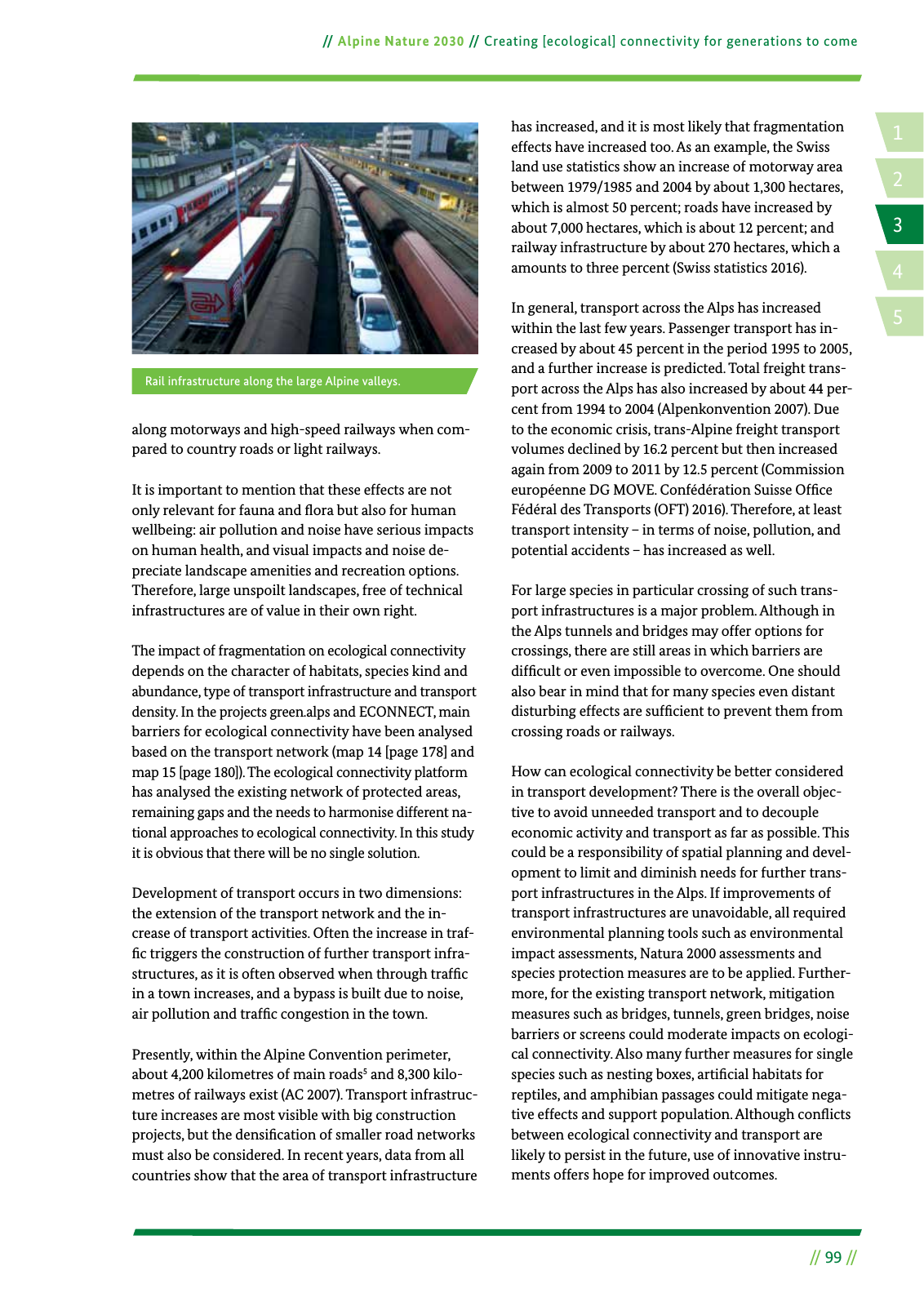14 2 5 3 Alpine Nature 2030 Creating ecological connectivity for generations to come 99 along motorways and high speed railways when com pared to country roads or light railways It is important to mention that these effects are not only relevant for fauna and ora but also for human wellbeing air pollution and noise have serious impacts on human health and visual impacts and noise de preciate landscape amenities and recreation options Therefore large unspoilt landscapes free of technical infrastructures are of value in their own right The impact of fragmentation on ecological connectivity depends on the character of habitats species kind and abundance type of transport infrastructure and transport density In the projects green alps and ECONNECT main barriers for ecological connectivity have been analysed based on the transport network map 14 page 178 and map 15 page 180 The ecological connectivity platform has analysed the existing network of protected areas remaining gaps and the needs to harmonise different na tional approaches to ecological connectivity In this study it is obvious that there will be no single solution Development of transport occurs in two dimensions the extension of the transport network and the in crease of transport activities Often the increase in traf c triggers the construction of further transport infra structures as it is often observed when through traf c in a town increases and a bypass is built due to noise air pollution and traf c congestion in the town Presently within the Alpine Convention perimeter about 4 200 kilometres of main roads5 and 8 300 kilo metres of railways exist AC 2007 Transport infrastruc ture increases are most visible with big construction projects but the densi cation of smaller road networks must also be considered In recent years data from all countries show that the area of transport infrastructure has increased and it is most likely that fragmentation effects have increased too As an example the Swiss land use statistics show an increase of motorway area between 1979 1985 and 2004 by about 1 300 hectares which is almost 50 percent roads have increased by about 7 000 hectares which is about 12 percent and railway infrastructure by about 270 hectares which a amounts to three percent Swiss statistics 2016 In general transport across the Alps has increased within the last few years Passenger transport has in creased by about 45 percent in the period 1995 to 2005 and a further increase is predicted Total freight trans port across the Alps has also increased by about 44 per cent from 1994 to 2004 Alpenkonvention 2007 Due to the economic crisis trans Alpine freight transport volumes declined by 16 2 percent but then increased again from 2009 to 2011 by 12 5 percent Commission européenne DG MOVE Confédération Suisse Of ce Fédéral des Transports OFT 2016 Therefore at least transport intensity in terms of noise pollution and potential accidents has increased as well For large species in particular crossing of such trans port infrastructures is a major problem Although in the Alps tunnels and bridges may offer options for crossings there are still areas in which barriers are dif cult or even impossible to overcome One should also bear in mind that for many species even distant disturbing effects are suf cient to prevent them from crossing roads or railways How can ecological connectivity be better considered in transport development There is the overall objec tive to avoid unneeded transport and to decouple economic activity and transport as far as possible This could be a responsibility of spatial planning and devel opment to limit and diminish needs for further trans port infrastructures in the Alps If improvements of transport infrastructures are unavoidable all required environmental planning tools such as environmental impact assessments Natura 2000 assessments and species protection measures are to be applied Further more for the existing transport network mitigation measures such as bridges tunnels green bridges noise barriers or screens could moderate impacts on ecologi cal connectivity Also many further measures for single species such as nesting boxes arti cial habitats for reptiles and amphibian passages could mitigate nega tive effects and support population Although con icts between ecological connectivity and transport are likely to persist in the future use of innovative instru ments offers hope for improved outcomes Rail infrastructure along the large Alpine valleys

Hinweis: Dies ist eine maschinenlesbare No-Flash Ansicht.
Klicken Sie hier um zur Online-Version zu gelangen.
Klicken Sie hier um zur Online-Version zu gelangen.